Systematic Review on Managing Asthma in Elderly Patients: Interventions and Challenges
This assignment focuses on the challenges faced in asthma management in older adults, specifically looking at the under-diagnosis and under-treatment of asthma in this population. The purpose of the systematic literature review is to identify interventions that can improve asthma symptoms in the elderly.
Added on 2023-04-25
About This Document
In this document we will discuss about Systematic Review on Managing Asthma in Elderly Patients and below are the summary points of this document:-
-
Asthma is an incurable respiratory disease that causes respiratory suffering, particularly in elderly patients.
-
Elderly patients suffering from asthma remain at high risk of ill health due to under-diagnosis and under-treatment.
-
A systematic literature review was conducted to understand interventions that can provide better progress in asthma symptoms for elderly patients.
Systematic Review on Managing Asthma in Elderly Patients: Interventions and Challenges
This assignment focuses on the challenges faced in asthma management in older adults, specifically looking at the under-diagnosis and under-treatment of asthma in this population. The purpose of the systematic literature review is to identify interventions that can improve asthma symptoms in the elderly.
Added on 2023-04-25
NURSING ASSIGNMENT
Name of the student:
Name of the university:
Author note:
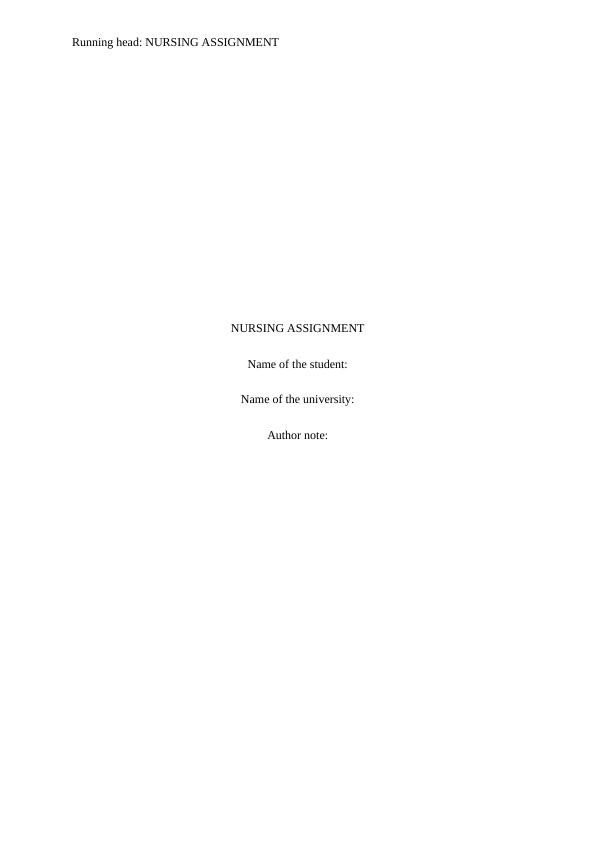
Abstract:
Asthma is an incurable health condition of the respiratory system which causes
respiratory suffering in patients. The disease roots irritation and narrowing inside of the lung,
limiting air supply. This respiratory condition has a major influence on aged population. It
has been observed that elderly patients suffering from asthma remain at high risk of
witnessing ill health due to asthma and the death rate is also found to be high. And the main
reason behind the issue is the ageing pathophysiology. In older patients, the under-diagnoses
of asthma are quite common hence the under-treatment occurs. And it has been observed that
management of aged asthma patient is challenging. In this systemic literature review, the
research problem considered will focus on the poor management of elderly asthma patient
and the research question “what interventions can provide better progress in asthma
symptoms for elderly asthma patients?”. The purpose of conducting this systematic review is
to develop a proper understanding about the interventions which can be helpful for aged
asthma patients and highlighting the factors that are creating challenges for these patients.
The review was performed in a planned and thorough way using proper database. The results
and conclusion has been provided in the paper.
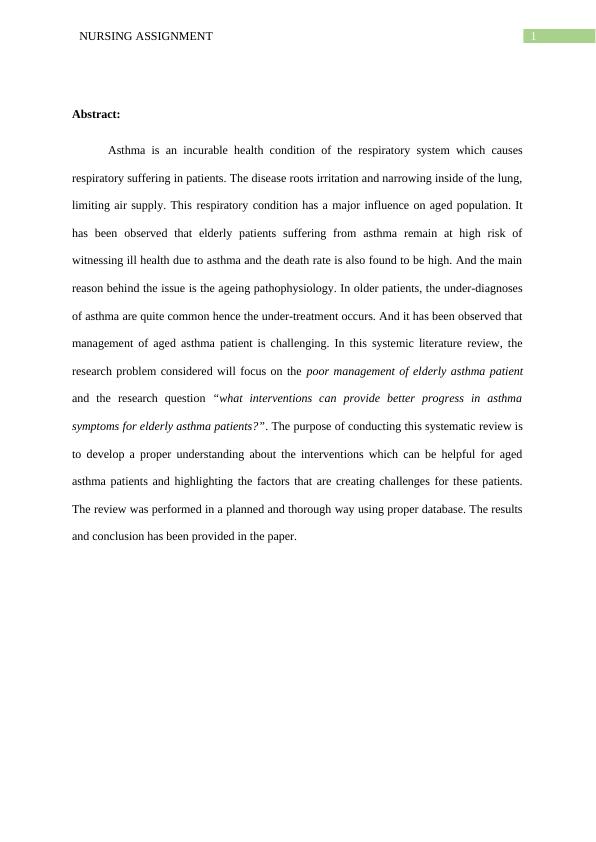
Table of Contents
Introduction:...........................................................................................................................3
Aim:........................................................................................................................................5
Objective:...............................................................................................................................5
Methodology:.........................................................................................................................6
Standards for including the studies:.......................................................................................6
Identification of studies:.........................................................................................................7
Study selection:......................................................................................................................8
Data extraction:......................................................................................................................9
Quality Assessment:...............................................................................................................9
Data Analysis:......................................................................................................................10
PRISMA Flow chart:........................................................................................................11
Results:.................................................................................................................................12
The impact of comorbidity on the treatment challenges in elderly people with asthma
disease..............................................................................................................................13
Challenges in the medication management and the adherence in elderly population
suffering with asthma.......................................................................................................14
Challenges due to the under-diagnosis of asthma in elderly people................................17
Appendix:.............................................................................................................................21
Discussion:...........................................................................................................................31
Conclusion:..........................................................................................................................38
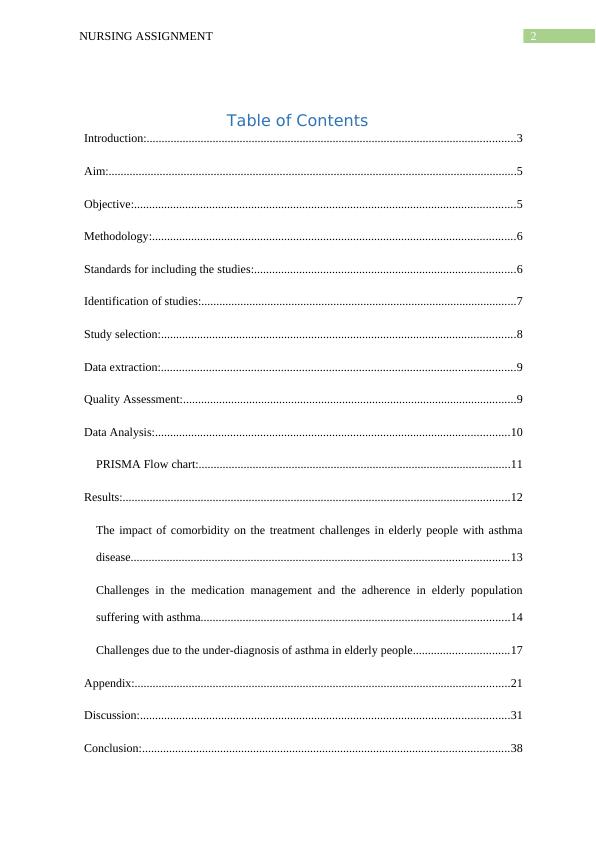
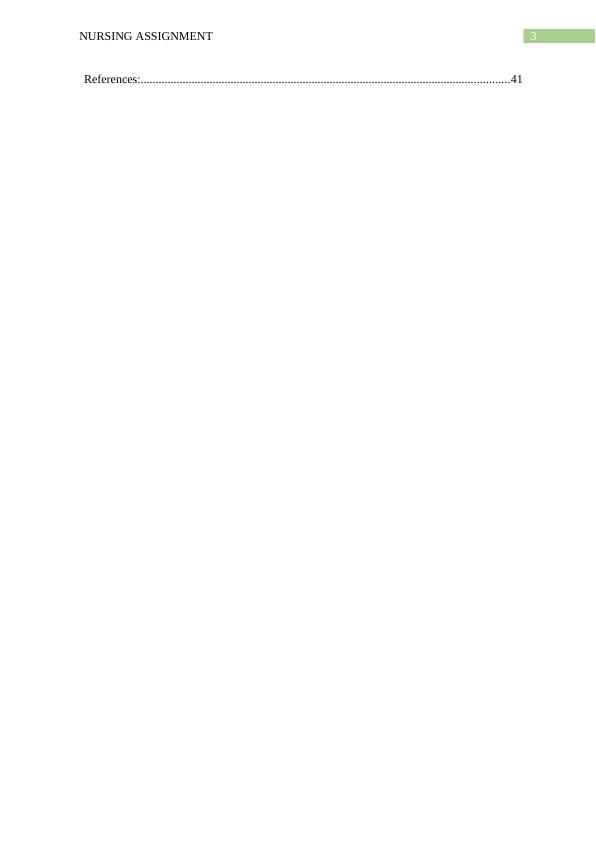
Introduction:
Asthma is a medical condition where the airways of the respiratory system starts becoming
narrow and swollen and excessive amount of mucus production is observed, causing
difficulty in breathing and induces, wheeziness, coughing and rapidity of breath (Ozturk &
Iliaz, 2016). According to th study conducted by the World Health Organization in the year
2016, it was reported that around 383000 death occurred throughout the world because of
asthma (World Health Organization, 2017). These death cases have become a major concern
for public health care in high revenue as well as low and mid revenue countries. And the most
of the cases of asthma related deaths are from low and mid income countries (D’amato et al.,
2015). Asthma is recognised as a disease of earlier adults but the death rate has been seen to
be higher in adults beyond 55 years of age. The disease is common in adults beyond the age
of 65 years and the risk is related to those of the younger asthma suffering patients (Gillman
& Douglass, 2012). The diagnosis of the disease can decrease the psychological and physical
value of life of older individuals. It is also being observed that the burden of disease has
increased with age and people in the age group of 75-79 witness the utmost effect
(globalasthmareport.org, 2014). The health management of asthma in older individuals gains
more attention because of the uneven burden of the disease in older and various risk factors in
the older group.
With the increasing aged people, the burden of the health care system should be
reduced focusing on the diseases that are common is elder population. The risk of asthma in
older people increases as their pulmonary tract changes because of ageing, challenges while
diagnosing and sever effects of treatment because of co-morbidities. These factors induce
challenges and complications for healthcare facilities while treating an elderly patient with
asthma. A review literature proposes under-diagnosis can be one of the management
experiments in asthmatic elder population. Pandya et al. (2016) stated that diagnosis is

complicated because most of the cardiovascular diseases mimic symptoms of asthma mostly
found in older population compared to the younger once. Chronic airflow hindrance and
symptoms of asthma may also get misdiagnosed as chronic bronchitis. Unpredictable
outcome in spirometry also induces challenges in elderly population (Gillman & Douglass,
2012). This research was not a population based and as it was conducted in a particular
hospital, only a narrow information was provided regarding the elderly asthma patient
diagnosis challenges. Benfante and Scichilone (2016) examined management challenges in
older individuals surfing from asthma and the research disclosed that less number of studies
have assessed the effect of various co-morbidities for controlling symptoms of asthma in the
elderly population. The research generally highlights the fact that there are various areas for
additional research for asthma management in older population.
The gaps in the research data remains concerning suitable mediations to overcome
some management challenges in asthma patients, performing a systematic review of
literature, focusing on the identification of the challenges in the asthma disease management
is essential. The systematic review and analysis of the research article focusing on the
involvements for asthma management and the connected issues can help in understanding the
barriers in the recovery process and refining the standard of life for the elderly asthma
patients. The main issue identified in the paper is the occurrence of the disease in elderly
patients and the growing health burden because of bad management in health care services.
The question in the research that would help in guiding the systematic review is as follows:
what interventions can provide better progress in asthma symptoms for elderly asthma
patients?

Aim:
The aim of the research is to progress on an understanding of all the variety of
interventions for older people suffering from asthma and the factors that are increasing the
challenges in the elder population, using systematic review.
Objective:
The key objectives of the systematic review are:
To achieve understanding about the management of the elderly asthma patients
To know the properties of the interventions for the older asthma population
To assess interventions executed for the management process for aged people.
Methodology:
For the aim of alignment of the result of the research at the end of the study with the
objective defined at the primary stage, it was found to be beneficial to perform the systematic
review. According to LoBiondo-Wood and Haber (2014), systematic review of a literature is
inclusive yet informative which focuses on empathy and following synthesis of current
studies. The main purpose of such studies is to précis the key findings of the present studies.
The systematic review of literature intended to associate important and significant research
outcomes on the management of the asthma disease in the elderly population so that the
participants remain informed about the exercise changes in the healthcare services in relation
to the management of asthma illness. In the systematic literature appraisals, the integrative
valuation of important data is organized from a chunk of information so that suitable
assumptions can be strained from it. As stated by Alligood (2017), a systematic review of
literature is to be taken as a process determined and inclusive review that centres on a specific
question. A refined methodology is to be followed for permitting a better result of the review.
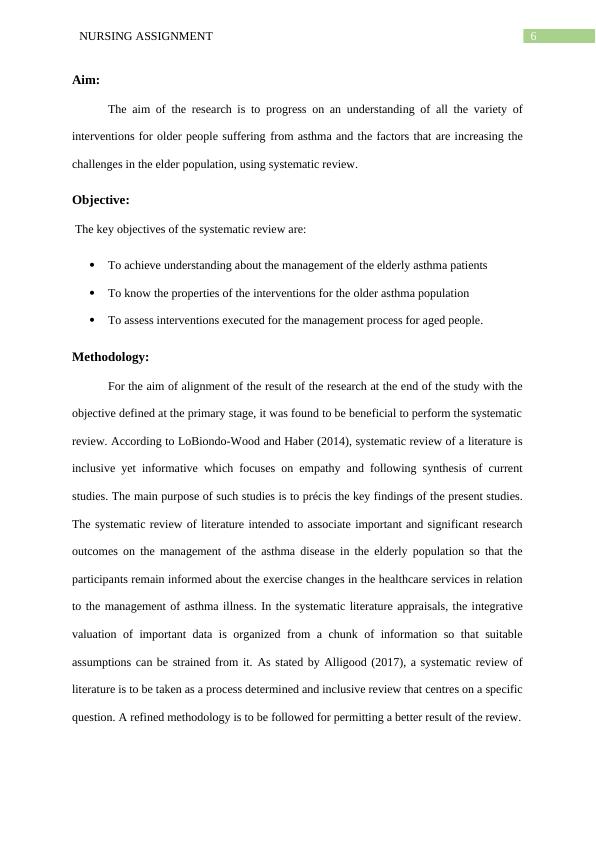
Standards for including the studies:
The inclusion and exclusion standard that is considered in a systematic review are the
reason behind setting limitations of the study. The two groups of standards expressed after
the question of the research is agreed, and before performing the research the search of the
essential articles are accompanied. Diverse factors can be considered as the inclusion and
exclusion standard (LoBiondo-Wood & Haber, 2014). These inclusion standards are the set
of features that the study selected should possess and the exclusion standard are the set of
features that prohibits the article from being incorporated in the systematic review. And for
this systematic review literature these standards of inclusion and exclusion was set early. The
inclusion standard comprised peer-reviewed research journals that has being recovered from
various sources and only those articles were selected, whose full excess was available. The
other criteria for the inclusion was the year of publication, which was after the year of 2009
and those who were available in English language. At last, the articles which had human
participant in them were important for the review purpose. Articles of last ten years were
taken in to account for developing main inferences from updated and current studies in
contrast to developing healthcare facilities in relation with asthma (Alligood, 2017).
Exclusion standards therefore were partial copy articles, those which were not published in
English and were before the year of 2009, and absenteeism of human volunteers in the
research. Articles from throughout the world were measured for growing the generalisability
of the research findings.
Identification of studies:
Databases- Electrical databases are influential and consistent tools that can be used by the
researchers throughout the world to engage in the secondary research which includes
systematic literature review. Suitable electrical databases need to be recognized and used for
performing the systematic examination successfully (LoBiondo-Wood & Haber, 2014). There

End of preview
Want to access all the pages? Upload your documents or become a member.
